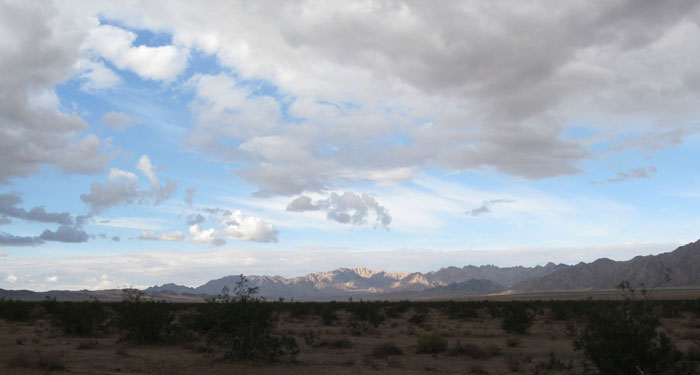Comments Due
November 18, 2010 - Submit Comments by November 26th
Comments on this project are welcome at anytime during the environmental review process. However, to ensure that comments will be addressed in the Final EIS/SA, the BLM must receive written comments on the Draft EIS/SA and Plan Amendment within 90 days following the date the Environmental Protection Agency publishes its Notice of Availability (NOA) in the Federal Register.
Comments addressed to BLM can be sent by e-mail CAPSSolarFirstSolarDesertSunlight@blm.gov, fax (760) 833-7199, or in writing to Allison Shaffer, Project Manager, Palm Springs South Coast Field Office, Bureau of Land Management, 1201 Bird Center Drive, Palm Springs, California 92262.
General Description of Project
First Solar Development, Inc. (First Solar) proposes to construct and operate a 550-megawatt (MW) solar photovoltaic (PV) power plant project known as the Desert Sunlight Solar Farm (DSSF or Project). The DSSF would include three main components 1) the Solar Farm site, 2) a transmission line, and 3) a Southern California Edison (SCE) owned and operated substation, Red Bluff Substation.
The Solar Farm site is on land administered by the Bureau of Land Management (BLM) six miles north of the rural community of Desert Center, which is adjacent to the I-10 freeway in eastern Riverside County, California.
The Project includes a 230-kV transmission line that would extend south from the Solar Farm site and interconnect to the planned Red Bluff substation near I-10. The Red Bluff Substation would interconnect with the existing SCE Devers-Palo Verde 1 transmission line. The three main project components will require a total of about 4,410 acres 4,090 acres for the Solar Farm, 230 acres for the transmission corridor, and 90 acres for the substation.
Below are some talking points that can be brought up in comment letters. Paraphrasing the below ideas would work best:
1. The DEIS lacks a reasonable range of alternatives.
2. The BLM should support a No Action Alternative that designates the area inappropriate for energy development.
3. The project area is important habitat for several sensitive species including Desert bighorn, burro deer, Palm Springs round tail ground squirrel and the federally threatened desert tortoise. The project area also represents an important connectivity corridor for these and other species.
4. The project area is important desert tortoise connectivity habitat between two US Fish and Wildlife Service designated Recovery Units.
5. The project area also represents important connectivity habitat between the lower elevation Chuckwalla Valley population of desert tortoise and the higher elevation Pinto Basin population of desert tortoise.
6. Desert tortoise found on the project site will be removed and translocated to the Chuckwalla Critical Habitat. According to the Fish and Wildlife Service, up to 50 percent or more mortality is expected for host and recipient populations of desert tortoise.
7. The project will remove 4,400 acres of foraging habitat for golden eagles. The nearest golden eagle nests are within one and a half miles. Loss of foraging habitat is considered a Take under the Bald and Golden Eagle Protection Act.
8. Construction of the project will remove habitat for 8 rare plants. There is no avoidance plan for the plants found on the site.
9. The project will create a visual polarized lake effect that will attract migratory birds and aquatic insects, endangering them with dehydration.
10. The project will be visible from several vantage points in Joshua Tree National Park and adjacent wilderness areas . The glow from night time lighting will also create a visual impact.
11. The project will negatively impact the quality of life for the adjacent property owners it will be built around.
12. Better alternatives can be found on disturbed ground and on rooftops in the built environment.
See more at Mojave Desert Blog: http://www.mojavedesertblog.com/2010/11/government-favors-destructive-layout-of.html
Public Meeting
October 20, 2010 - Desert Center, Riverside County, California - About 40 people showed up to the Lake Tamarisk Community Center to attend the meeting over the Bureau of Land Management Draft Environmental Impact Statement for the proposed 4,400 acre remote photovoltaic facility that would be known as the Desert Sunlight Solar Farm (DSSF). Ironically, the rain poured down on the building as the applicant, First Solar LLC, told the crowd about the unlimited solar insolation in the local region.
The meeting was another in a series of public meetings designed to identify and resolve outstanding issues that would arise from the dramatic alterations to the landscape from the construction of this facility. First Solar LLC has an application with the Bureau of Land Management for a Right of Way application for over 14,000 acres of public land to construct a utility-scale photovoltaic facility. The actual project that is being considered for development is 4,410 acres. The DSSF would include three main components: 1) the Solar Farm site, 2) a transmission line, and 3) a Southern California Edison (SCE) owned and operated substation, Red Bluff Substation. A 230-kV transmission line would extend south from the Solar Farm site and interconnect to the planned Red Bluff substation near Highway I-10. The Red Bluff Substation would interconnect with the existing SCE Devers-Palo Verde 1 transmission line. The three main project components will require a total of about 4,410 acres: 4,090 acres for the Solar Farm, 230 acres for the transmission corridor, and 90 acres for the substation.
The meeting was advertised in local papers as a "hearing”, however the only people allowed to speak to the crowd were the associate field manager of the BLM Palm Springs Field Office, the director of business development for First Solar, and a representative from Southern California Edison.
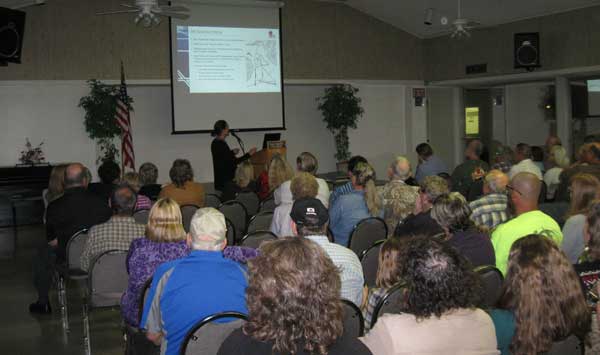
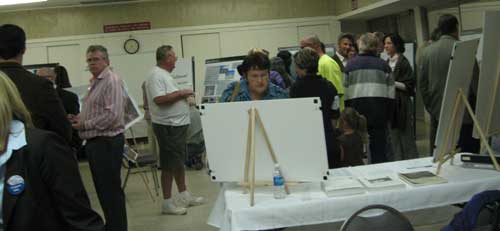
Business director Kim Oster presented a downright spiffy speech highlighting the economic and environmental benefits of the Desert Sunlight project. If one were uneducated about utility scale solar energy and the footprint of this project, one would assume that the DSSF could do no wrong to the local community or the environment. If one, however, visited the site, they would see a beautiful, unbroken Colorado Desert landscape nestled right next to Joshua Tree National Park.
Oster delivered the all too familiar spin that we have heard from many solar developers concerning their Right of Way proposal compared to their actual footprint. The Right of Way requested for this project is over 14,000 acres while the actual development footprint would only be 4,400 acres. That is over 5 square miles! Just about every solar farm proposal on public lands has had a ROW that is two to four times bigger than the actual footprint of the project. That is common. It is quite deceiving to suggest that their actual project footprint reduction from the ROW is their “environmental reconfiguration”. That is usually decided by the BLM, not the applicant. Oster also told the crowd that First Solar met with several environmental organizations and First Solar, and reconfigured the project even more and have now resolved most of the environmental conflicts. She claimed that the removal of five square miles of habitat is somehow free of environmental conflicts.
Yet she still admitted that the desert to be removed represents important connectivity habitat for desert tortoise, bighorn sheep, burro deer and other wildlife.
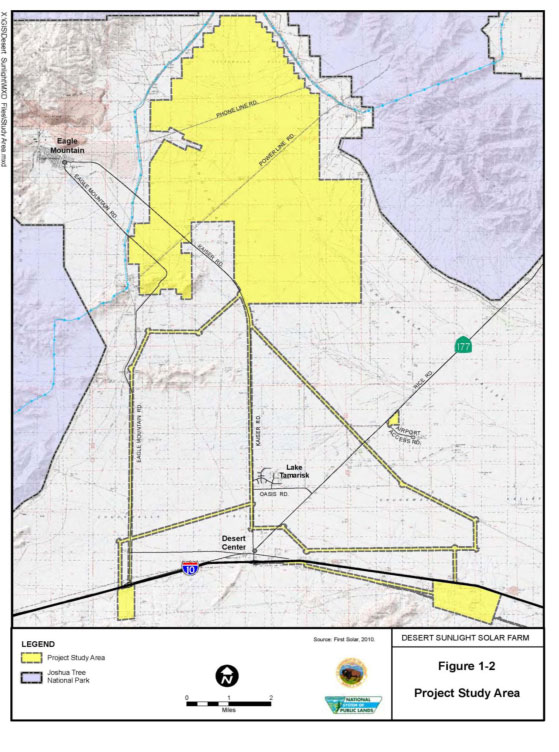
^Project Study Area in yellow, actual project would be smaller within this.
First Solar made the claim that there are only 6 desert tortoises on the site. In reality, this is the number of actual tortoises found on the surveys. This number has jumped around dramatically during the history of this project. The current reconfiguration of the project now indicates a lowest density population. They claim to have met with several representatives from different big environmental organizations and as a result, resolved issues concerning sensitive species. They claim, for example, that their reconfiguration of the project will only require movement of 12 desert tortoise. This number is based on the actual 6 found in the preliminary surveys and a statistical population estimate. They claim to have avoided the best habitat. Our review is that the habitat on the site is favorable for desert tortoise and it is well known among scientists that this region represents an important connectivity zone between the Chuckwalla Valley population and the Pinto Basin population. Because the Chuckwalla population of desert tortoise resides at a lower population, some biologists believe that the connectivity zone that this project would remove represents a potential “climatic” migration corridor. As temperatures rise as predicted, this corridor would be crucial for desert tortoise and other species as a link to a cooler region, essential to the survival of the population.
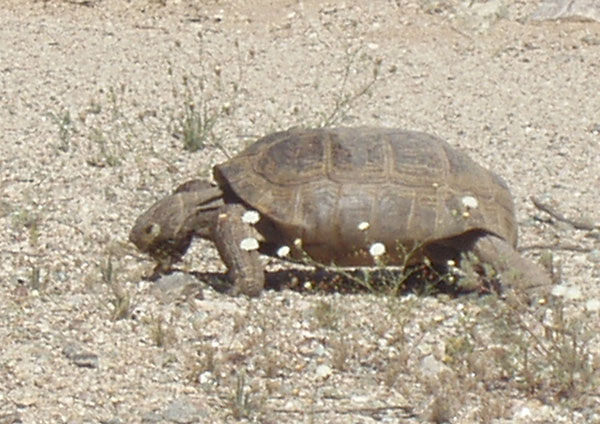
^Desert tortoise eating pinchushion flowers (Chaenactis sp.) near the project site.
A similar fast tracking schedule was implemented for the Ivanpah Solar Electric Generating System project located to the north in the Mojave Desert. BrightSource, the company building the project stated that only 36 desert tortoise would be found on their entire project site. As it turns out, they have found 38 just in the first phase of three on the project site. Nine of these are juveniles. The US Fish and Wildlife Service has determined that all desert tortoise translocation and relocation projects result in 50 percent mortality in both the host and recipient populations. That means that half of all tortoise that are moved will die and half of the population that the relocated tortoises are added to will eventually die. Reasons for this include disease, predation, home range, and carrying capacity. When tortoises are moved, they spend time looking for their home range. This can cause stress and the lack of cover can be a death trap, exposing tortoises to predators. And one of the tortoises excavated in Ivanpah Valley has already been killed by a coyote. About 50 percent of all the desert tortoise translocated from the Ft. Irwin expansion in 2008 were killed by predators.
We believe that it is very possible that First Solar is grossly underestimating the amount of desert tortoise residing on the Desert Sunlight site. First solar also plans to move the tortoise that they excavate onto the Chuckwalla Desert Wildlife Management Area which is designated Critical Habitat for the recovery of the species. This will endanger this protected population. Moving desert tortoise onto a Critical Habitat has only been tried on Ft. Irwin with disastrous results.
First Solar also claims that they avoided all of the rare plants located in the region. They showed us the map they made of the reconfigured project and sure enough, the symbols representing the rare plants were mostly located off of the project site. We reminded them that annual plants do not always sprout in the same exact location year after year and limited surveys will not represent a comprehensive story of the population dynamics. The project will be micro-graded meaning all vegetation will be removed and herbicides will be used to control the spread of weeds. There is no safety or mitigation plan to protect adjacent local land owners from the hazards of exposure to these chemicals.
There is also no avoidance plan for rare plants located on the site.
First Solar claims that no water will be used to wash off the panels - ever! While thin film can attain efficiency with little cleaning, we question the applicant's statement that they will never need to clean off these panels. First Solar claims that they will wash the panels of their Silver State project in Nevada twice a year.
See the BLM web page.

^Map showing creosote bush community in yellow and Ironwood wash forest in green, within the actual project site that will be graded.
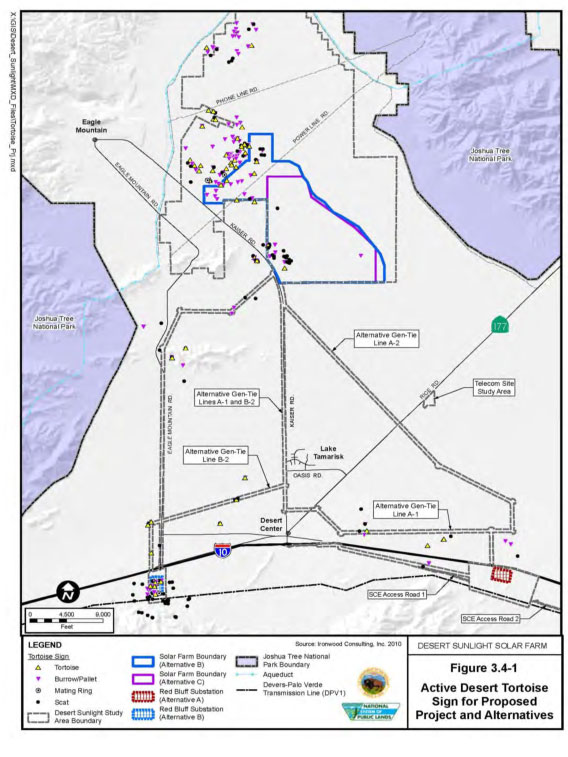
^Tortoises, burrows and other sign in the area.
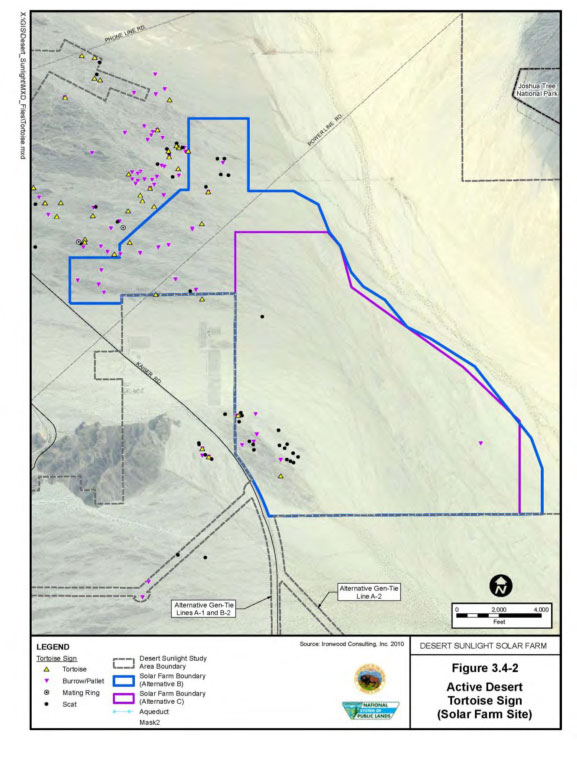
^Tortoise and sign around and in the project site.
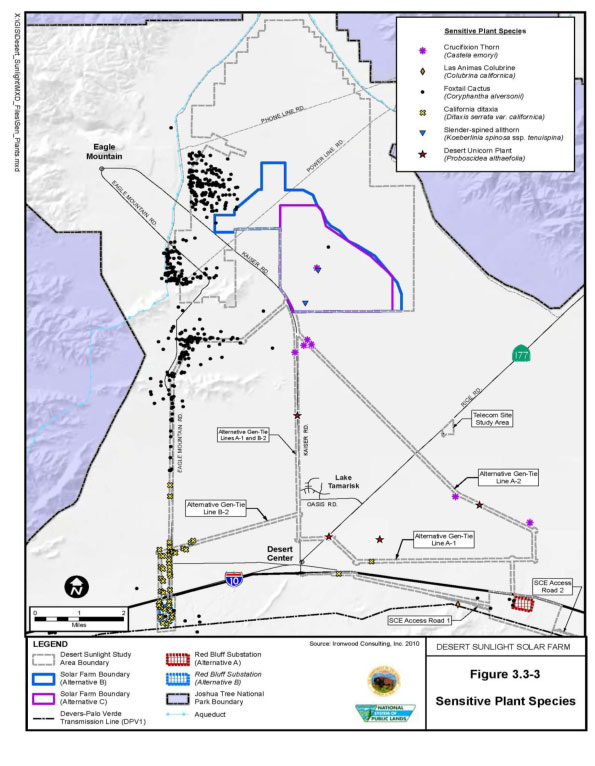
^Rare plants.

^Wildlife observations.
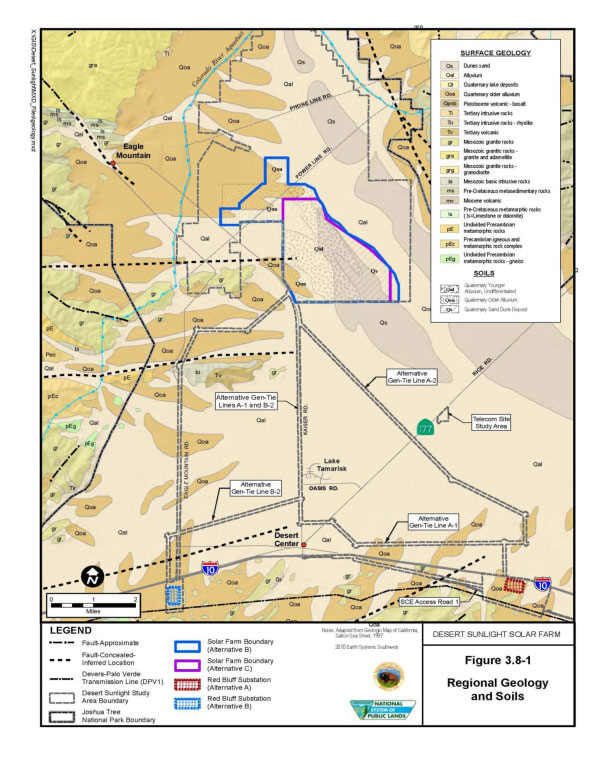
Rain in the Desert
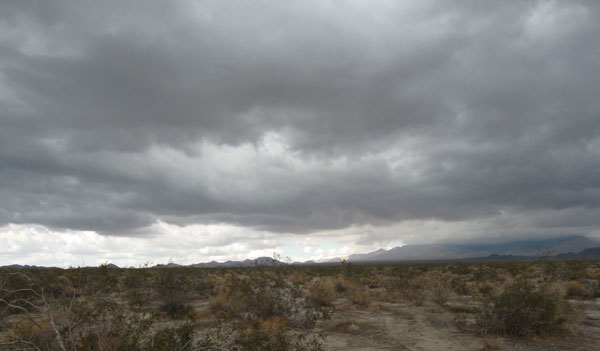
^The day of the scoping meeting the rainclouds gathered over the project site and it poured.

